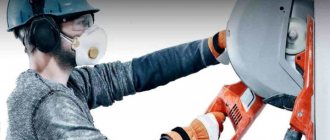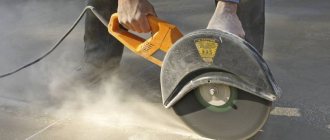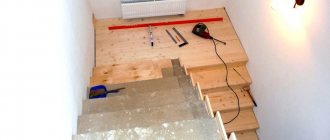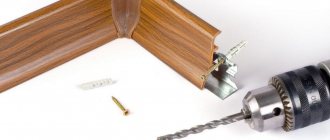Cutting openings in Moscow
one of the most popular services provided by our company. Diamond cutting is a highly efficient and versatile technology for creating openings, windows and vents. Our company works with any types of walls and ceilings, including load-bearing walls (both brick and concrete). We use only the most modern equipment, and our employees literally “ate the dog” in the redevelopment, reconstruction and refurbishment of residential, public and industrial buildings.
Making and strengthening openings using diamond cutting is fast and safe. We conclude official contracts with each of our customers, and also provide a hidden work certificate and SRO approval. Among other things, our company arranges openings in load-bearing walls according to the plans of design bureaus.
Diamond cutting of concrete
Diamond cutting of concrete is considered the most popular method, and has the following advantages compared to other types:
- The work does not pose a danger to the walls. The vibration that is created during diamond cutting is much less than the vibration created when punching openings with a hammer drill, so the risk of cracks appearing in the walls is significantly reduced.
- Accuracy. Diamond cutting of concrete ensures that cuts are made along the marking lines accurately and at the required angles.
- Low noise level. Diamond cutting of concrete produces noise that does not exceed sanitary standards.
- Minimum amount of dust and debris. During such cutting of openings in concrete walls, the appearance of cracks is not provoked, therefore, chips do not appear during work, which results in the absence of debris.
Cutting holes in a concrete wall using the diamond drilling method.
Unfortunately, diamond cutting of concrete also has disadvantages, the main of which can be considered the following:
- High energy consumption.
- The unit must be cooled with water.
- High cost of consumables, which are coated circles.
How to order a service?
The price for such types of work is fixed and depends on the material and construction features. We guarantee:
- granting SRO access;
- deadlines;
- use of modern equipment;
- high-quality, clean performance of the service;
- conclusion of a hidden work act.
If you require the creation of an additional opening, please contact. You can place an order on our website using the convenient form or by calling the numbers provided. Our specialists are always in touch and ready to answer any questions. – it’s very easy to remodel with us!
Minimum order value: 8000
Cost of cutting the opening: from 600
/meter
Prices Online calculation
Waterjet method for cutting concrete
Slightly less popular than diamond cutting is the waterjet method, which is cold cutting. In this case, the opening in the concrete slab is made under the influence of a stream of water, which is mixed with sand, which acts as an abrasive. The jet has a diameter of about 0.4 mm.
The liquid is fed under pressure into a special tank in which it is mixed with sand. Then, through the nozzle, the resulting mixture comes out at high speed (about 1000 meters per second) and is directed towards the material that needs to be cut.
Using the waterjet method for cutting concrete walls.
To extinguish the residual force of the jet, a special water trap is used. If the jet pressure is low, you can remove the necessary part of the concrete without affecting the reinforcement, and with high pressure you can cut right through the concrete.
The waterjet method of cutting concrete has advantages:
- Precision and neatness of cuts.
- Compliance with environmental standards. During operation, gases and fumes that are harmful and dangerous to human health are not released.
- Absence of thermal and mechanical influences on the slots.
- Absence of strong noise and vibration during operation.
- Possibility of cutting at any desired angles.
- The ability to give doorways any unusual shapes.
There are few disadvantages to this method of cutting concrete openings:
- High cost of abrasive.
- The installation is large in size, which is why it cannot be used in residential areas.
Finishing work
The order of the final stage:
- Clean the weld seams.
- Fill the cavities between concrete and metal parts with cement mortar.
- Putty the walls.
- Install the door frame and door.
To complete all stages of work, high-quality tools and highly qualified workers are required. The cutting method allows you to make openings and niches, so these tasks are relevant for all repair work inside buildings. If you need to make openings in a concrete wall, you should contact professionals.
Oxygen lance drilling of concrete
You can make an opening in a concrete slab using oxygen lance drilling, a cutting process that uses an oxygen lance, which is a thick-walled metal pipe saturated with oxygen.
The spear is heated to a very high temperature (about 1360-1400°C), for which foreign objects are used - welding, a torch. Once the spear is ignited, the burner is removed. The end of the pipe begins to burn at a temperature of 2000°C. To increase the thermal force, a steel rod is placed in the spear.
When the spear comes into contact with concrete, the resistance of densely flowing slag is overcome. At the same time, the concrete surface does not emit its own heat, it is not subject to oxidative processes, and when the tube is removed, it quickly cools down.
For this reason, it is not recommended to make reciprocating movements when working. For more efficient punching, the tube rotates during operation (drilling is obtained), but it is necessary to ensure that it burns and does not go out.
The disadvantage of this type of work is considered to be an increased danger for the worker performing it - hot slag particles fly in different directions over a distance of several meters.
How to decide on the choice of tool?
Parameters that must be taken into account when widening and drilling openings in concrete:
- Covering material. In a concrete layer, cutting gives an absolutely even cut, unlike brickwork.
- Layout of load-bearing walls and partitions. All work carried out on load-bearing walls is approved by regulatory authorities so as not to weaken the load-bearing capacity.
- Permissible noise level.
- Product size.
- Safety.
- Appearance and shape of the hole produced. Often the cuts are made square, but separate segments are used for individual parts of the structure to achieve the desired look, for example, for arches.
Diamond cutting is most often used, which is considered the most profitable and safe.
There is no impact noise when cutting with diamond coating. A strong frequency of sounds is observed when working with gas cutters or crowns when entering a wall cavity. When choosing a tool, you should pay attention to its size. The large dimensions of the waterjet unit do not make it possible to use it inside apartments. When performing work, the safety of the worker making the hole should also be taken into account. For example, oxygen-lance drilling is particularly dangerous, since waste slag particles, when heated, reach high temperatures and fly apart up to 2 meters. It is most profitable and safe to use diamond wheels and crowns, which are used even in hard-to-reach places, but you should also pay attention to the material of construction, as well as the required depth of the holes.
Tools for cutting concrete openings
Drilling is used to make technological holes, sockets, and furrows. If it is necessary to make openings in concrete walls or expand existing openings, diamond cutting elements, which are fixed in various tools, are often used.
If the thickness of the concrete slab is small, an angle grinder, popularly called a “grinder”, with wheels with a diameter of 105 to 125 mm is used for cutting.
Cutting concrete using a grinder.
Spraying water while working will reduce dust and at the same time help preserve the disc. If a situation arises in which contact with water is dangerous, you need to perform dry cutting.
However, even with dry cutting, in order to cool the segments, it is necessary to remove the disk from the cutting area at certain intervals so that the machine runs “idle” for 10-50 seconds.
To cut an opening in a concrete slab, the depth of which exceeds 10 cm, professional circular saws are used, which are hydraulic and electric cutters. This tool quickly cuts through concrete up to 15 cm deep on one side.
They work with disks with a diameter of 350-500 mm. When cutting openings in concrete, it is necessary to wear a respirator, since if concrete dust enters a person’s lungs, serious illnesses can develop. In addition, hands should be protected with gloves, and eyes with special glasses.
To pour or not to pour?
The disadvantages listed above, coupled with the need to cut solid building materials, forced builders to search for solutions to this problem. Solution: suppress dust by supplying water to the cutting zone. The liquid binds volatile particles and turns them into dirt. It is enough to direct the jet at the disk, and the centrifugal force will deliver the water straight to the cut. That is why all modern cutters are equipped with built-in nozzles for carrying out the so-called. "wet" diamond cutting. Water not only extinguishes dust, but also cools the segments on the disk, which increases the service life of the tool and prevents them from being soldered off if the cutting wheel is not soldered using a laser. This technology has become widespread and has been introduced into all areas of industrial, civil and road construction.
However, dry diamond cutting has also proven to be in demand in areas where there are no high requirements for dust (for example, the work of road workers) and where the specifics of the object do not allow the use of water. For example, working in close proximity to electrical panels, high-voltage cables and, of course, where finishing is done. The fact is that the water supplied to the cut can be localized, the excess can be collected with a vacuum cleaner, the perimeter of the opening can be covered with film, but not one of the methods can guarantee 100% absence of leaks. This is especially true when cutting brick, where there is a possibility of sludge spreading over the masonry. At the same time, the use of dry cutting in order to preserve the finish is not suitable at all - remember about 80 m/s - because dust gets into all the smallest folds and it is often simply impossible to hide from it.
How wall thickness affects concrete cutting
The size of the wall thickness is the main indicator by which it is determined which cutting method to use.
- The grinder can cope with a slot depth not exceeding 10 cm.
- With a concrete slab thickness of 8-10 cm, a machine with increased power is required for operation.
- When the thickness of the concrete slab is 15-16 cm, a circular saw is used, the diameter of the discs should be 350-400 mm. If you use a grinder, the work will have to be carried out in several stages, and the tool may overheat and break.
- If the concrete is 30 cm thick or more, use a special wall cutting tool - manual or machine.
- Concrete, the thickness of which reaches 60 mm, is cut using a tool such as a chain saw, a ring cutter.
- A concrete slab whose thickness exceeds 60 cm is cut with special equipment. A disc with a diameter of 100 mm or more is used. Rope cutting devices can also be used.
Selection of diamond blades
The choice of cutting blade should be based on the required outer diameter.
The main cutting element used for cutting concrete is a diamond blade. There are mainly two types of such discs: segmented and turbo diamond designs. The latter type is significantly more expensive, but can be used at high speeds (especially wave-body designs). Segmented discs contain individual diamond segments attached to the body; their strength is somewhat worse, but the cost is much lower.
Based on the type of fastening of the segments, segmented disks are divided into two main types. The most widespread (as cheaper) disks with soldered elements using silver solder. More reliable (especially when cutting dry) are discs on which the segments are laser welded.
The cutting disc should be selected according to the required outer diameter and the diameter of the mounting hole, but taking into account its required strength. In addition, discs have different diamond content, which is always reflected in the brand or instructions. If you need to cut a particularly strong wall, then you need to choose a tool with a maximum diamond content. Among specific types of disks, we can recommend domestic designs “Adel”, “Vyatichi”, “Kermet”, “Zenezis”, as well as foreign ones - “Terminator”, “Tyrolit”, “Hilti” and some others.
Carrying out cutting of a concrete opening
Before you start cutting a doorway in a concrete wall (or expanding it), you need to mark the wall: use chalk or a pencil to draw the necessary lines. In order to make the slot even, attach slats along the markings, along which it is more convenient to move the grinder. Plastic anchors are used to secure the slats.
Before starting work, it is necessary to install temporary support structures.
We use a grinder to cut a concrete opening.
The “grinder” moves along the guide rails, cutting 1 cm deep around the perimeter of the future opening. Pre-slotting determines whether the disc has been selected correctly, so after performing this, carefully inspect the disc and assess the degree of wear. If you do not notice damage to the disk, then continue to use it. The deepening of the cut should be gradual (no more than 15 mm each).
When the concrete wall thickness is more than 100 mm, a special concrete saw is used. When cutting through reinforcement, it is necessary to reduce the cutting speed. The work is carried out according to the same principle as with a grinder - each cut should not exceed a depth of 3 cm.
MANUFACTURING OPENINGS OF DIFFERENT TYPES
Our company produces the following types of openings:
Door
We make doorways in brick and concrete walls using special wall-cutting machines, which are characterized by high accuracy. They are also suitable for creating fire and basement entrances, garage doors, interior doors in residential buildings, cottages and private sector buildings.
Window
Many older buildings have very small basement windows, which do not let in enough light and can even complicate evacuation during an emergency. Cutting window openings allows you to set them to the dimensions that you need. And we’re not just talking about basement windows - often when replacing old frames with new ones, it is necessary to enlarge existing ones. It is most convenient to cut them out from the outside, since in this case the concrete or brick dust will go directly into the ground along with the water.
On the floor
Such openings may be needed when combining separate apartments or when converting a basement/attic into living space. The optimal way to make them is horizontal sawing with a diamond blade, which can easily cope with both reinforced concrete floors and asphalt road surfaces.
How to strengthen a concrete opening
After you have cut out the opening or expanded it, you need to reinforce the walls with additional metal structures.
Strengthening openings can be as follows:
- Single row. To construct this type of fortification, a channel is used. You need to make a U-shaped frame around the opening. In this design, various types of channels are used, and fastening to the walls can be done in various ways. Places where the channel does not adhere to the wall must be filled with mortar.
- Ugolkov. Edging is done with corners on both sides of the wall. To fasten the corners to each other, pins and metal plates are used. These are the most common designs.
- Combined. The openings are strengthened using channels and corners.
How to coordinate openings in load-bearing walls
The arrangement or expansion of openings in a concrete wall must be carried out in accordance with all standards and have permission from the relevant authority. When making a decision to carry out redevelopment, you need to take into account a number of indicators:
- The number of the floor on which the redevelopment work will be carried out (the load on the walls will be less, the higher the floor on which the apartment is located).
- What year was the house built?
- What is the width of the opening and where is it located (at the junction of the slabs, at what distance to the external walls).
- What condition are the walls in the room?
The redevelopment of an apartment can be entrusted to employees of organizations that have permission to carry out such construction work. Nowadays, very often owners remodel buildings and apartments, widen old openings in the walls, and install new ones.
- Diamond cutting is considered the leader in building dismantling work. The cutting elements are capable of cutting through a concrete wall whose thickness exceeds 60 cm.
- Cutting using the waterjet method is more environmentally friendly and safe.
- A good effect is obtained when using oxygen-lance drilling, however, certain training and experience are required to perform the work. You can get burned if you do not follow safety precautions when working.
Considering the thickness of the concrete walls in which you need to make or enlarge the opening, and also depending on the result you want to get, you can choose the cutting method that is more suitable for you.
The main thing, when carrying out work, do not forget that the changes that will occur in the load-bearing walls must be carefully calculated and approved by the appropriate authority, and the openings must be strengthened.
Making doorways
Particular attention should be paid to the manufacture of doorways
, because cutting them into the wall is a very complex and complex process. In addition, any such work must be coordinated with the housing inspection, since it directly affects the load-bearing structures of the building. In order to reduce the risk of violating their integrity, it must be reinforced with a U-shaped metal frame.
The process of making a doorway can be divided into 3 stages:
- Installation of a reinforcing beam.
- Punching.
- Contour gain.
The reinforcing beam is installed in order to support the weight of all upper floors and evenly redistribute the load exerted by them, since the load-bearing capacity of the partition in which the door is broken through inevitably decreases. Typically such beams are made of steel. At the place where they are installed, the masonry is first cut with wall chasers and equipped with steel angles or channels, and only then the beam itself is fixed to them. All remaining seams are carefully covered with mortar.
It is most convenient and safe to make doorways using diamond cutting. Tools using this technology do not impact the walls, which can lead to cracks in them. And in general, the process itself is very neat and almost silent. Openings are cut using powerful yet quiet wall saws. They cut the material into individual blocks, which are subsequently removed by hand.
Making a doorway reduces the strength of the overall structure of the house. To neutralize this undesirable effect, the hole should be reinforced with a special frame. It is installed in such a way that the ends of the beams extend beyond the edges of the opening by 10-25 centimeters, and is secured in the masonry with anchors. Calculations for strengthening and redistributing the load in this case should be performed by design specialists.
Openings in load-bearing walls
Making an opening in a load-bearing wall involves cutting out an entire fragment of this wall and then strengthening it. Since such work can lead to a decrease in the load-bearing capacity of the entire building, it cannot be carried out without a project and appropriate permission from the regulatory authorities.
How to cut openings in load-bearing walls?
The most suitable equipment for making openings in load-bearing walls is one that will not create strong vibrations and significant dynamic loads on the structure. These requirements are fully met by diamond equipment, the discs of which can cope with even the most durable material and at the same time operate absolutely silently. The opening is not cut in one step - concrete blocks weighing up to 40 kilograms are removed from the wall one by one. If necessary, the wall can be strengthened with unloading jack stands, which are installed before starting work.
Openings in the walls of panel houses
Our employees have experience in cutting openings in houses of almost all current panel series, including:
- houses of series I: I-155-B (“Tower”), multi-section houses I-155 MK and I-155Mm, I-155-N;
- P series houses: P-111M, P-121M, P-3M, P-3M-7/23, P-30M, P-44K, P-44M, P-44T, P-44TM, P-44TM/25 ( TM-25), P-46M and P-55M;
- houses of the Domkon series;
- houses of the Kolos series;
- houses of the "Jubilee" series:
- houses of other series (KOPE, MES, IP, MG 601, GMS, PD, RD, S-220/222).
Let us note that the work on cutting and strengthening the openings is finally completed only when they are accepted by a representative of the design organization according to the appropriate act. The work must be carried out in strict accordance with the previously developed project, otherwise the inspection certificate simply will not be signed.
Creating openings in monolithic reinforced concrete walls
Our company is also ready to provide services for cutting openings in reinforced concrete monolithic walls. The need to carry out such work arises quite often - for example, during the construction or redevelopment of residential complexes and shopping centers. The wall saws we use are able to penetrate reinforced concrete to a depth of up to 30 centimeters without making annoying noise or generating cubic meters of dust. For even thicker walls, hydraulically driven wall cutters or diamond drilling units are used.
What happens if you cut openings without the necessary documents?
Making an opening without design documentation in a wall that is not load-bearing is theoretically permissible, but the opening that appears will have to be legalized in any case, only after the redevelopment has been completed. But it’s better not to even approach load-bearing walls without approval. Firstly, any interference in their design can lead to the most dire consequences. And secondly, such arbitrariness will most likely be recognized as unauthorized redevelopment and appealed in court, which in most cases forces the owner of the premises to seal the “unauthorized” opening.











